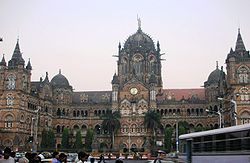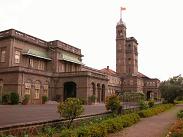 Central Railway was formed on 5th November 1951 by combining the Great Indian Peninsula Railway, Nizam State Railway and Scindia/Dholpur State Railways, consequent upon integration of Indian State Railways with the Indian Government Railways.
Central Railway was formed on 5th November 1951 by combining the Great Indian Peninsula Railway, Nizam State Railway and Scindia/Dholpur State Railways, consequent upon integration of Indian State Railways with the Indian Government Railways.
It all began one fine summer day on 16 April 1853. It was a single step of 34 kilometers from “Boree Bunder” (now Chhatrapati Shivaji Terminus) to “Tannah” (now Thane). G.I.P. Railway’s first train ever to run on the Indian soil rolled out and changed the history of India, forever. It also marked the dawn of the Railway Age in Asia – the world’s largest continent.
The railway line was extended from Thane to Kalyan (20 kilometers) after about a year. From Kalyan, the railway line branched into two directions, viz. the North Eastern line leading towards Igatpuri and Bhusaval and the South Eastern line towards Pune and Solapur. It took 7 to 9 years to construct the lines through the two ghat sections (Bhor and Thull). The mountain barriers, which those lines surmounted, had only one parallel at that time in the history of railway construction – the Semmering Pass in the Austrian Alps. The period 1861 to 1870 was very important for the G.I.P. Railway, because during this period, the fast growing industrial town of Mumbai was linked with Calcutta, the imperial capital of India. During the same decade, Bombay (now Mumbai) was linked with Madras (now Chennai) as also with Nagpur.
The Central Railway is one of the largest of the 16 zones of Indian Railways. Its headquarters is in Mumbai at Chhatrapati Shivaji Terminus (formerly Victoria Terminus). It includes the first passenger railway line in India, which opened from Bombay to Thane on April 16, 1853. The central railway covers a large part of the state of
Maharashtra and parts of North-Eastern Karnataka and Southern Madhya Pradesh.
 The railway zone was formed on November 5, 1951 by grouping several government-owned railways, including the Great Indian Peninsula Railway, the Scindia State Railway of the former princely state of Gwalior, Nizam State Railway and the Dholpur Railways. The Central Railway zone formerly included northern Madhya Pradesh and Chhattisgarh states and part of southern Uttar Pradesh, which made it the largest railway zone in India in terms of area, track mileage and staff. These areas became the new West Central Railway zone in April 2003.
The railway zone was formed on November 5, 1951 by grouping several government-owned railways, including the Great Indian Peninsula Railway, the Scindia State Railway of the former princely state of Gwalior, Nizam State Railway and the Dholpur Railways. The Central Railway zone formerly included northern Madhya Pradesh and Chhattisgarh states and part of southern Uttar Pradesh, which made it the largest railway zone in India in terms of area, track mileage and staff. These areas became the new West Central Railway zone in April 2003.
From 1.4.2003, after the reorganization of zonal railways, Central Railway is a network of 3905.47 route kilometres and 5975.33 track kilometres connecting 476 stations over 5 divisions spanning across the states of Maharashtra, Madhya Pradesh, and Karnataka plays a key role in the progress of the nation as a carrier of passenger and freight traffic.
Central Railway is the premier passenger carrying system amongst all Indian Railways. It carries over 4 lakh passengers daily to every nook and corner of the country through about 548 mail/express/passenger trains. Mumbai suburban train system is the lifeline of this metropolis where 3 million commuters travel every day in 1236 local trains serving 73 stations. Central Railway also runs 40 suburban services on Pune-Lonavla section.
Workshops
Loco Workshop, Parel.
Carriage & Wagon Workshop, Matunga
Mechanical Workshop (NG), Kurduwadi
Tank Wagon Workshop, Kurla
Electrical Loco Workshop, Bhusaval
Traction Machine Workshop, Nasik Road
Central Engineering Workshop, Manmad
Signal & Telecommunication Workshop, Byculla.
CURRENT OPENINGS
click above to know
more about central railway
Sponsored Links
